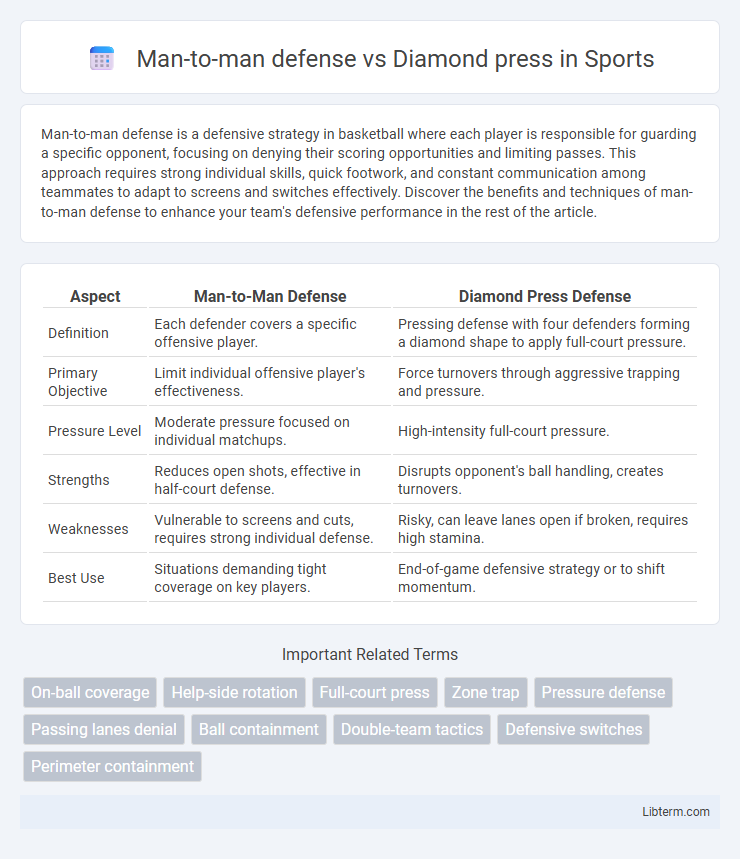Man-to-man defense is a defensive strategy in basketball where each player is responsible for guarding a specific opponent, focusing on denying their scoring opportunities and limiting passes. This approach requires strong individual skills, quick footwork, and constant communication among teammates to adapt to screens and switches effectively. Discover the benefits and techniques of man-to-man defense to enhance your team's defensive performance in the rest of the article.
Table of Comparison
| Aspect | Man-to-Man Defense | Diamond Press Defense |
|---|---|---|
| Definition | Each defender covers a specific offensive player. | Pressing defense with four defenders forming a diamond shape to apply full-court pressure. |
| Primary Objective | Limit individual offensive player's effectiveness. | Force turnovers through aggressive trapping and pressure. |
| Pressure Level | Moderate pressure focused on individual matchups. | High-intensity full-court pressure. |
| Strengths | Reduces open shots, effective in half-court defense. | Disrupts opponent's ball handling, creates turnovers. |
| Weaknesses | Vulnerable to screens and cuts, requires strong individual defense. | Risky, can leave lanes open if broken, requires high stamina. |
| Best Use | Situations demanding tight coverage on key players. | End-of-game defensive strategy or to shift momentum. |
Introduction to Man-to-Man Defense and Diamond Press
Man-to-man defense assigns each defender to guard a specific offensive player, emphasizing individual accountability and physical pressure. Diamond press is a variant of press defense arranged in a diamond shape, designed to trap ball handlers and force turnovers through aggressive, coordinated positioning. Both defenses aim to disrupt offensive rhythm, but man-to-man prioritizes close coverage while diamond press focuses on trapping and creating chaos.
Key Principles of Man-to-Man Defense
Man-to-man defense emphasizes individual accountability, requiring each defender to closely match up with a specific offensive player, maintaining tight on-ball and off-ball coverage to prevent scoring opportunities. Principles such as communication, proper stance, and the ability to anticipate the opponent's moves are essential for effective execution, ensuring defenders can switch and help without leaving gaps. This defense relies on physicality, agility, and constant pressure to disrupt offensive flow, contrasting with the Diamond press's coordinated trap formations and full-court pressure tactics.
Core Structure of the Diamond Press Defense
The core structure of the Diamond Press defense centers on a tight, aggressive man-to-man marking system arranged in a diamond shape to apply intense pressure on the ball handler and passing lanes. This formation positions four defenders strategically: one at the top of the key pressuring the inbound pass, two wings covering the sidelines for traps, and one defender at the baseline to prevent easy outlets. The Diamond Press disrupts offensive rhythm by forcing turnovers through coordinated traps and relentless on-ball pressure, maximizing defensive effectiveness through spatial control and communication.
Strengths of Man-to-Man Defense
Man-to-man defense excels in applying consistent pressure on individual opponents, allowing defenders to exploit mismatches and limit scoring opportunities. This defense promotes strong communication, quick reactions, and personalized coverage, which disrupts offensive rhythm and forces turnovers. Man-to-man defense also adapts effectively to various offensive sets by maintaining close, physical coverage on ball handlers and key passers.
Advantages of the Diamond Press System
The Diamond Press defense enhances team pressure by trapping ball handlers and forcing turnovers through aggressive double-teaming, creating chaos in the opponent's backcourt. Its compact formation allows defenders to quickly rotate and cover passing lanes, disrupting the offense's rhythm and limiting easy scoring opportunities. This system effectively exploits ball control weaknesses and increases defensive intensity, leading to fast-break opportunities and momentum shifts.
Weaknesses and Limitations of Both Defenses
Man-to-man defense often struggles with vulnerabilities such as ineffective perimeter coverage and difficulty containing quick ball handlers, leading to mismatches and open shots. The Diamond press defense, while aggressive in creating turnovers, tends to leave gaps in the interior defense, making it susceptible to inside scoring and fast breaks. Both defenses require high stamina and discipline, with man-to-man prone to fatigue-related lapses and Diamond press risking overcommitment and easy penetration if the press is broken.
Tactical Scenarios: When to Use Each Defense
Man-to-man defense is ideal for scenarios requiring tight individual coverage and quick adaptation to offensive players' movements, particularly effective against teams with strong one-on-one scorers. The Diamond press is best utilized in high-pressure situations to force turnovers and disrupt the opponent's ball control, especially during critical moments when aggressive trapping can capitalize on mistakes. Coaches often choose man-to-man defense to contain shooters and isolate threats, while the Diamond press excels in creating chaos and speeding up the pace against less skilled ball handlers.
Player Skills Required for Each Defensive Approach
Man-to-man defense demands exceptional individual skills such as lateral quickness, closeout speed, and one-on-one defensive positioning to effectively guard assigned opponents. Diamond press requires advanced communication, anticipation, and trap execution abilities to coordinate aggressive double-team presses and cut off passing lanes. Both defensive approaches mandate high basketball IQ and stamina to sustain pressure and adapt to offensive movements.
Transitioning Between Man-to-Man and Diamond Press
Transitioning between man-to-man defense and diamond press requires precise communication and spatial awareness to maintain defensive pressure without leaving gaps. Players must quickly adjust their positioning, with man-to-man emphasizing individual matchups while diamond press focuses on trapping in the backcourt to force turnovers. Effective transitions hinge on recognizing opponent ball movement and seamlessly shifting from tight individual coverage to coordinated double-teaming strategies.
Impact on Team Performance and Game Outcomes
Man-to-man defense enhances team performance by fostering individual accountability and improving perimeter defense, leading to higher defensive intensity and reduced scoring opportunities for opponents. Diamond press disrupts offensive rhythm through aggressive full-court pressure, increasing turnovers and fast-break chances that can shift game momentum. Teams employing these defenses strategically often experience improved game outcomes by balancing tight coverage with pressure tactics that exploit opponent weaknesses.
Man-to-man defense Infographic

 libterm.com
libterm.com